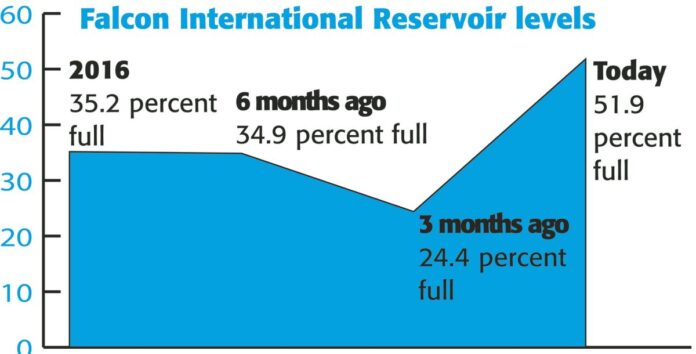HARLINGEN — Heavy rains in the vicinity of Laredo two months ago answered the prayers of many a Valley farmer.
Low levels at Falcon International Reservoir appeared to be a bleak signal for growers, who can be limited in how much they can irrigate crops in the winter if water is scarce.
But what meteorologists refer to as a “river of deep tropical moisture” was the protagonist in the story, flowing from the eastern tropical Pacific Ocean through Mexico and into the Upper Valley.
Combining with the remnants of Tropical Storm Pilar, the river in the sky dropped 10 to 15 inches of rain in
Webb County and eight to 10 inches of rain along the Rio Salado to the west and northwest of Falcon International Reservoir on Sept. 25-26 and significantly eased the threat of winter drought.
These tropical downpours quickly poured into the Rio Grande in Webb County, creating a “flood wave” along the river with moderate flooding in and near Laredo.
On Sept. 28, the peak stages of 26.94 feet at Columbia Bridge ranked fourth-highest all time and the highest since June 2013.
“The high waters damaged U.S. Border Patrol equipment, including at least one generator, two light poles and one or two submerged vehicles,” reported National Weather Service meteorologists in Brownsville.
Most importantly for the agricultural industry in the Rio Grande Valley, the flooding reached the Falcon International Reservoir, and helped raise its level from 24.4 percent full three months ago to 51.9 percent full today.
Drinking water for the Valley from Falcon reservoir and Amistad Lake is always the priority for local water districts in South Texas which depend on those reservoirs.
But levels as low as 24 percent probably would have forced agricultural interests to go without water when it comes to irrigation.
“Each district has a certain ownership allotment of water,” Dale Murden, president of Texas Citrus Mutual, said in an email. “The water districts that use more ultimately have less during drought. So they ration, so to speak.”
As of Nov. 2, the U.S. Drought Monitor lists northeastern Cameron County, southern Willacy County and parts of Starr County as abnormally dry. Much of Starr County is worse off, and is listed as being in moderate drought.
The rainfall in the Upper Valley six weeks ago more than doubled Falcon reservoir’s storage in one week, from 550,000 acre-feet to more than 1.1 million acre-feet.
“The fortunate — one might say serendipitous — rains provided welcome water into Falcon, which could have faced significant shortages in what is a confident forecast of a warmer and drier than average late autumn 2017
through spring 2018,” meteorologists in Brownsville wrote.
“Such shortages may have required irrigation rationing, and while smart irrigation and conservation is always a reality for the Rio Grande Valley’s agricultural economy, having the additional storage removes worries —
temporarily — for growers and municipalities should they need to draw from Falcon in early 2018,” meteorologists concluded in an analysis posted on their website.
– Five-mile rolled earth fill and concrete embankment completed in 1954
– Power generation began in 1954
– Dam is 150 feet above bed of Rio Grande
– Crest elevation is 323 feet above mean sea level
– Total water capacity is 2.65 million acre-feet with surface are of 85,195 acres
– Reservoir operated jointly by United States and Mexico
Source: International Boundary Waters Commission






